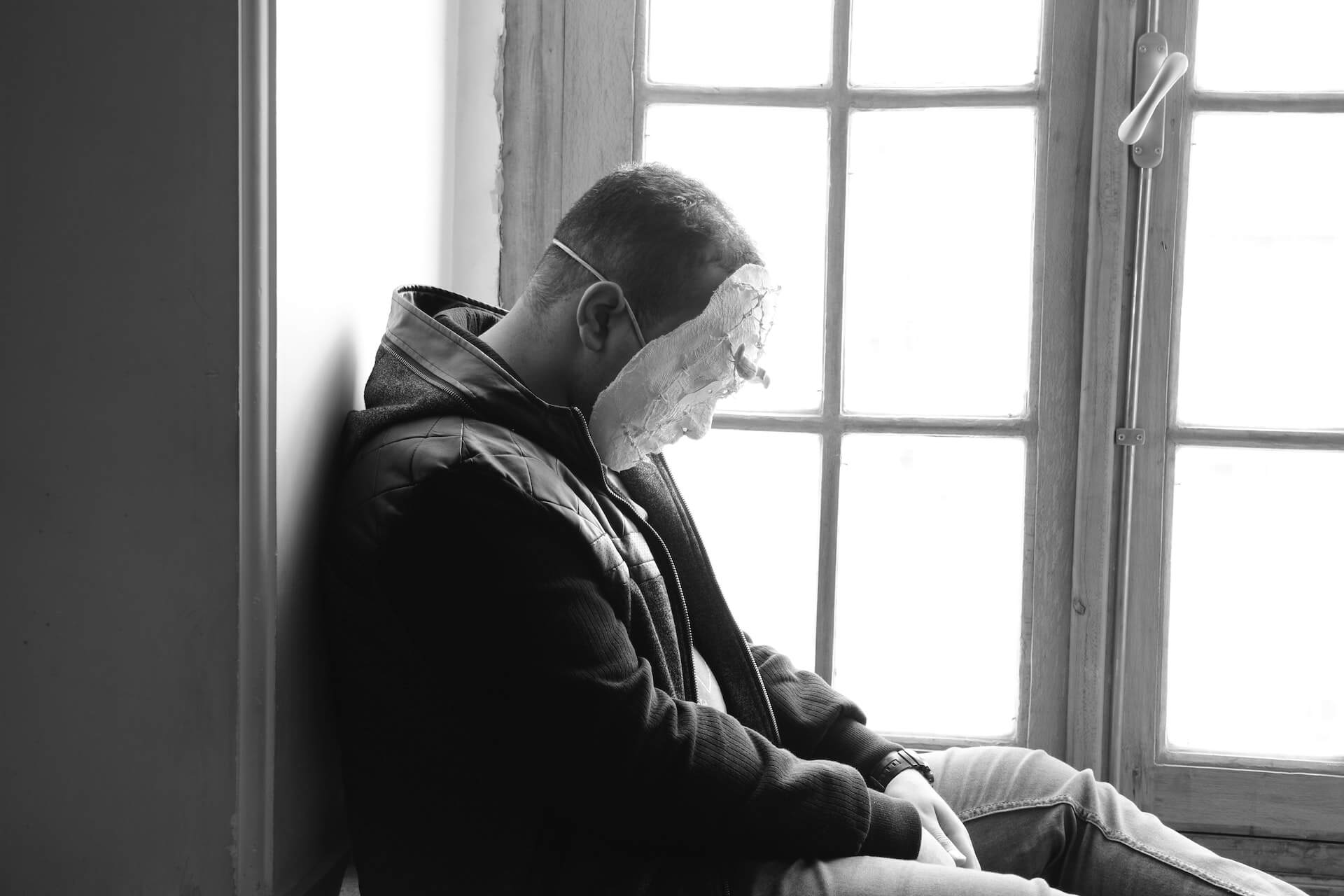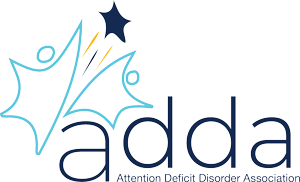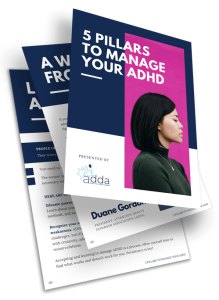
ADHD Masking: Does Hiding Your Symptoms Help or Harm?
How hard would it be to swim gracefully while holding a beach ball under the water?
You might be able to do it for a while, but eventually, that ball will surface. Keeping it underwater will take a lot of energy – and the same goes for hiding your ADHD symptoms.
Instead of letting those around you know about your challenges, you may have learned to compensate for them in different ways,
This might include coming up with “reasonable” excuses for being late or distracted. Maybe you tend to suppress stimming behaviors like bouncing your legs or chewing on the end of your pen.
This is what’s known as ADHD masking.
It happens when a person tries to hide their ADHD symptoms to blend in with the crowd and protect themselves from judgment. This is done by mimicking the behaviors of those around them.
In some instances, it might be a helpful strategy. But it comes at a cost because maintaining the mask is draining and isolating. That’s why it can lead to burnout and affect a person’s mental health.
Read on to learn how to stop ADHD masking and regain your confidence.
Originally published on May 1st, 2023, this article was updated and republished on August 1st, 2024.
Understanding ADHD Masking
Masking is when a person with ADHD acts in a “socially acceptable” way to fit in and form better connections with those around them.
This usually involves camouflaging their symptoms by controlling their impulses, rehearsing responses, and copying the behaviors of those who don’t have ADHD.

Keep in mind that masking does not mean you’re fake or ingenuine. It’s often a learned response based on what society views as “normal.” Many adults with ADHD mask their symptoms to prevent them from interfering with their relationships and social life.
Some people mask unknowingly, while others are aware of it. This ability to adapt socially is usually learned from childhood, which can complicate or delay proper diagnosis.[1]
Research also suggests that women with ADHD are less likely to be diagnosed than men with ADHD due to these compensatory mechanisms and masking behaviors.[2]
If you’re looking for resources to learn more about ADHD masking, check out ADDA+. It’s a supportive community providing helpful tools, resources, and encouragement to empower you to live your best life.
The Signs Of ADHD Masking
ADHD masking can take many different forms. Knowing what it looks like can help you recognize and understand it better.
In general, you can split masking into two main groups: masking in inattentive-type ADHD and masking in hyperactive-type ADHD.
Examples of ADHD Masking
Different forms of ADHD can lead to different masking symptoms.
For instance, predominantly inattentive ADHD is linked to difficulty focusing, trouble listening during conversations, poor organization, forgetfulness, and a lack of time management.[3]
One example of ADHD masking for these inattentive-type symptoms is a behavior known as stimming.
ADHD stimming describes a self-soothing or self-stimulating behavior that involves making the same movements, actions, or sounds repeatedly. Examples include rocking back and forth, humming, or grinding your teeth.
ADHD masking by stimming might help improve focus, reduce boredom, and self-soothe.
Apart from stimming, other examples of inattentive ADHD masking include:
- Coming up with excuses for being late or distracted (without harmful intentions)
- Putting in twice the amount of effort and time than others to achieve a goal
- Working extra hard to complete tasks right before the deadline
- Checking your work multiple times before submission
- Focusing intensively during conversations to keep up
- Being extra early to events to avoid being late
- Having multiple alarms and reminders set up
- Writing everything down
Hyperactive-type ADHD typically involves fidgeting, talking excessively, being unable to wait your turn, or being unable to sit still.[3]
Examples of masking for this form of ADHD may include:
- Staying silent in conversations or being extra cautious with your words
- Suppressing your energy to appear calm
- Suppressing the urge to fidget or stim
- Bottling strong emotions up
Often, masking feels like living with two different personas. The first is for when you’re alone or with those you feel comfortable around, and the other is for when you’re around colleagues, classmates, and other people you don’t know well.
ADHD Masking Vs. Managing ADHD
ADHD masking isn’t always bad. Certain coping strategies, like fidgeting, may be harmless and maybe even useful if they help with symptoms.
Masking can result in a person learning to adapt and function better in their work, relationships, and at home. This can help prevent your life from getting derailed by your symptoms (not just hiding or denying them).
These coping strategies can help manage ADHD, but it’s important to note that they develop due to a person adapting to mask their symptoms.

Here are some examples of healthy compensation mechanisms of masking:
- Making it a point to listen actively during conversations, especially with a partner or loved one
- Setting multiple reminders to ensure you remember important work and family events
- Jotting down ideas or important things to remember whenever they come into mind
- Decluttering and organizing your workspace to help you focus
Consequences Of Masking
For many people, masking takes a lot of mental and emotional energy. Like swimming with that beach ball, it isn’t easy.
Other issues can include:
- Having trouble finding support when facing ADHD-related challenges
- Complicating or delaying a diagnosis, leading to untreated ADHD[4]
- Developing anxiety and depression from undiagnosed ADHD
- Having trouble differentiating what’s real and what’s an act
- Having perfectionist tendencies and lower self-esteem
- Feeling burnout from having to act a certain way [5]
- Becoming anxious or tense around other people
- Feeling alone or isolated
It’s best to assess how masking impacts you and identify which behaviors are helpful and which are harmful. For example, learning how to organize your workplace might be frustrating at first, but it can lead to better focus and work performance.
On the other hand, if certain forms of masking have taken a toll on your mental health, unmasking may be the best decision to make. It can be daunting, but it’s a change that many ADHDers don’t regret making.
It’s still important to have your ADHD professionally diagnosed and treated, as this can help lighten the mental load of masking. And there are plenty of ADHD resources and avenues for support that can help you.
What Is ADHD Masking Burnout?
ADHD masking takes a lot of time and energy. You may also constantly worry that someone might find out you’re “putting on a show.”
In the long run, ADHD masking might lead to burnout symptoms, including:
- Feeling exhausted for no apparent reason
- Experiencing anxiety or depression
- Turning to unhealthy coping mechanisms, such as alcohol
- Having strained social relationships and keeping yourself isolated
How Can Unmasking Help?
When you unmask, you allow your friends and family to understand your ADHD challenges and support you better. This makes it easier for you to seek support and encouragement when you need it.
It also reduces the emotional and mental weight of having to act and talk a specific way whenever you’re around people.

For some people, unmasking gets them closer to an accurate diagnosis. It can also be the first step to building greater self-love and confidence.
Just remember to be patient and compassionate with yourself during the process.
5 Tips To Help You Unmask Your ADHD
You don’t have to unveil your true persona in every situation. That can feel overwhelming. Instead, decide who you feel comfortable unmasking for. Then, you can develop a gradual plan to do so.
Here are five tips to help you out with unmasking your ADHD:
- Identify when and why you mask your symptoms. Many ADHDers mask unknowingly. Try to be aware of how you behave around certain groups of people. Identify situations that cause discomfort, and reflect on why your mask goes up. This allows you to assess all your masking behaviors and differentiate helpful from harmful ones.
- Explore alternatives for unhealthy masking behaviors.There are ways to manage your symptoms without masking. For example, if loud parties and large gatherings drain you, make it a point to leave the event earlier instead of completely rejecting invites. Or, if you tend to suppress all your emotions, try to talk to a therapist to learn how to acknowledge and regulate them better.
- Don’t be afraid to speak about your ADHD challenges. Inform your closest friends and family members about your struggles with ADHD. Then, gradually move on to your other relationships. You can also ask those around you to help spot and point out your usual masking behaviors so you’re more aware of when they happen.
- Understand that you don’t have to journey alone. Living with ADHD can sometimes feel like an isolated and lonely path. By connecting with other ADHDers, you can seek support, encouragement, and advice from others who have been down the same road. ADDA’s virtual support groups can help you find an online community where you can express yourself without judgment.
- Seek professional treatment and support. ADHD medications can improve symptom management. Additionally, therapy can help you learn how to replace self-limiting thoughts with healthier, self-motivating ones. An ADHD therapist or ADHD coach can also help you improve your organization, prioritization, and time management skills.

Balancing The Double-Edged Sword Of ADHD Masking
Unhealthy masking behaviors often lead to burnout. One of the best ways to prevent this is by helping others see the world through the lens of your brain. This can relieve the pressure of putting on a show and help you build a support system for when you need one.
Ultimately, what people think of you doesn’t have to hold you back from living a happy and fulfilling life with ADHD. Remember to celebrate your strengths and victories.
References
[1] Kosaka, H., Fujioka, T., & Jung, M. (2019). Symptoms in individuals with adult-onset ADHD are masked during childhood. European archives of psychiatry and clinical neuroscience, 269(6), 753–755. https://doi.org/10.1007/s00406-018-0893-3
[2] Young, S., Adamo, N., Asgeirsdottir, B. B., Branney, P., Beckett, M., Colley, W., Cubbin, S., Deeley, Q., Farrag, E., Gudjonsson, G. H., Hill, P. S., Hollingdale, J., Kilic, O., Lloyd, T., Mason, P. W., Paliokosta, E., Perecherla, S., Sedgwick, J., Skirrow, C., . . . Woodhouse, E. (2020). Females with ADHD: An expert consensus statement taking a lifespan approach providing guidance for the identification and treatment of attention-deficit/ hyperactivity disorder in girls and women. BMC Psychiatry, 20(1). https://doi.org/10.1186/s12888-020-02707-9
[3] de la Peña, I. C., Pan, M. C., Thai, C. G., & Alisso, T. (2020). Attention-Deficit/Hyperactivity Disorder Predominantly Inattentive Subtype/Presentation: Research Progress and Translational Studies. Brain sciences, 10(5), 292. https://doi.org/10.3390/brainsci10050292
[4] Rivas-Vazquez, R. A., Diaz, S. G., Visser, M. M., & Rivas-Vazquez, A. A. (2023). Adult ADHD: Underdiagnosis of a Treatable Condition. Journal of Health Service Psychology, 49(1), 11–19. https://doi.org/10.1007/s42843-023-00077-w
[5] Ginapp, C. M., Greenberg, N. R., Macdonald-Gagnon, G., Angarita, G. A., Bold, K. W., & Potenza, M. N. (2023). The experiences of adults with ADHD in interpersonal relationships and online communities: A qualitative study. SSM – Qualitative Research in Health, 3, 100223.





